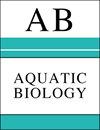鲤鱼和非洲鲶鱼对池塘生态系统浮游生物、周围植物和底栖大型无脊椎动物的影响
IF 0.8
4区 生物学
Q3 MARINE & FRESHWATER BIOLOGY
引用次数: 2
摘要
鲤鱼鲤和非洲鲶鱼通过其底栖体影响水生生态系统的生物组合,它们的引入已被认为是一个环境问题。我们比较了在马拉维Zomba国家水产养殖中心的池塘生态系统中,普通鲤鱼和非洲鲶鱼对邻近的浮游生物、周围植物、底栖大型无脊椎动物和本地罗非鱼的营养级组合的影响。研究涉及四种处理:有鲤鱼的池塘(T1),有非洲鲶鱼的池塘(T2),有鲤鱼和非洲鲶鱼的池塘(T3),没有鲤鱼和非洲鲶鱼的池塘(T4)。在所有处理中,地方性夏尔罗非鱼(Oreochromis shiranus)也作为当地大型动物群的一部分存在。结果表明:T1海域浮游植物丰度最高,浮游动物、底栖动物和大型无脊椎动物丰度和多样性最低;T4区浮游植物最少,但浮游动物、周围植物和底栖大型无脊椎动物的数量和种类最多。T2与T3(中间至T1和T4)浮游植物、周围植物和底栖大型无脊椎动物的丰度和多样性均无显著差异。T3池水质状况改善,原生罗非鱼生物量增加。研究结果表明,在非洲鲶鱼的水生生态系统中养殖鲤鱼不会对环境产生不利影响,非洲鲶鱼与鲤鱼混养可作为一种管理策略,以减轻非洲鲶鱼对环境的潜在不利影响。本文章由计算机程序翻译,如有差异,请以英文原文为准。
Effects of common carp and African catfish on plankton, periphyton, benthic macroinvertebrates in pond ecosystem
As the common carp Cyprinus carpio and African catfish Clarias gariepinus affect biotic assemblages in aquatic ecosystems through their benthivory, their introduction has been considered an environmental concern. We compare the effects of common carp and African catfish on adjacent trophic level assemblages of plankton, periphyton, benthic macroinvertebrates and native tilapia in a pond ecosystem at the National Aquaculture Center, Zomba, Malawi. Four treatments were involved in the study: ponds with common carp (T1), ponds with African catfish (T2), ponds with both common carp and African catfish (T3), and ponds lacking both common carp and African catfish (T4). In all treatments, the endemic Shire tilapia Oreochromis shiranus was also present as part of the local macrofauna. Results showed that T1 had the most abundant phytoplankton but the lowest periphyton, zooplankton and benthic macroinvertebrate abundance and diversity. T4 had the least phytoplankton but the most abundant and diverse zooplankton, periphyton and benthic macroinvertebrates. There was no significant difference between T2 and T3 (both intermediate to T1 and T4) in terms of phytoplankton, periphyton and benthic macroinvertebrate abundance and diversity. Better water quality regime and increased biomass of native tilapia fish were observed in T3 ponds. We conclude that the farming of common carp in aquatic ecosystems containing African catfish may not adversely affect the environment and that the polyculture of African catfish and common carp can be adopted as a management strategy to mitigate the potential adverse effects of common carp.
求助全文
通过发布文献求助,成功后即可免费获取论文全文。
去求助
来源期刊

Aquatic Biology
生物-海洋与淡水生物学
CiteScore
2.70
自引率
0.00%
发文量
7
审稿时长
3 months
期刊介绍:
AB publishes rigorously refereed and carefully selected Feature Articles, Research Articles, Reviews and Notes, as well as Comments/Reply Comments (for details see MEPS 228:1), Theme Sections, Opinion Pieces (previously called ''As I See It'') (for details consult the Guidelines for Authors) concerned with the biology, physiology, biochemistry and genetics (including the ’omics‘) of all aquatic organisms under laboratory and field conditions, and at all levels of organisation and investigation. Areas covered include:
-Biological aspects of biota: Evolution and speciation; life histories; biodiversity, biogeography and phylogeography; population genetics; biological connectedness between marine and freshwater biota; paleobiology of aquatic environments; invasive species.
-Biochemical and physiological aspects of aquatic life; synthesis and conversion of organic matter (mechanisms of auto- and heterotrophy, digestion, respiration, nutrition); thermo-, ion, osmo- and volume-regulation; stress and stress resistance; metabolism and energy budgets; non-genetic and genetic adaptation.
-Species interactions: Environment–organism and organism–organism interrelationships; predation: defenses (physical and chemical); symbioses.
-Molecular biology of aquatic life.
-Behavior: Orientation in space and time; migrations; feeding and reproductive behavior; agonistic behavior.
-Toxicology and water-quality effects on organisms; anthropogenic impacts on aquatic biota (e.g. pollution, fisheries); stream regulation and restoration.
-Theoretical biology: mathematical modelling of biological processes and species interactions.
-Methodology and equipment employed in aquatic biological research; underwater exploration and experimentation.
-Exploitation of aquatic biota: Fisheries; cultivation of aquatic organisms: use, management, protection and conservation of living aquatic resources.
-Reproduction and development in marine, brackish and freshwater organisms
 求助内容:
求助内容: 应助结果提醒方式:
应助结果提醒方式:


